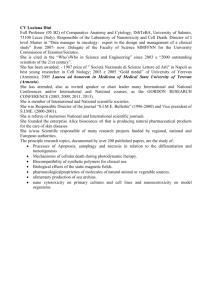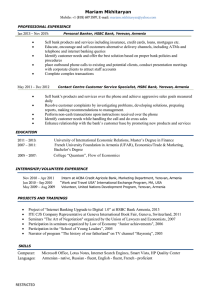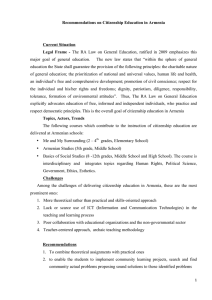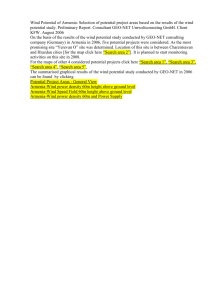Armenia and UTMB Partnership in Primary Care 1999-2004
advertisement
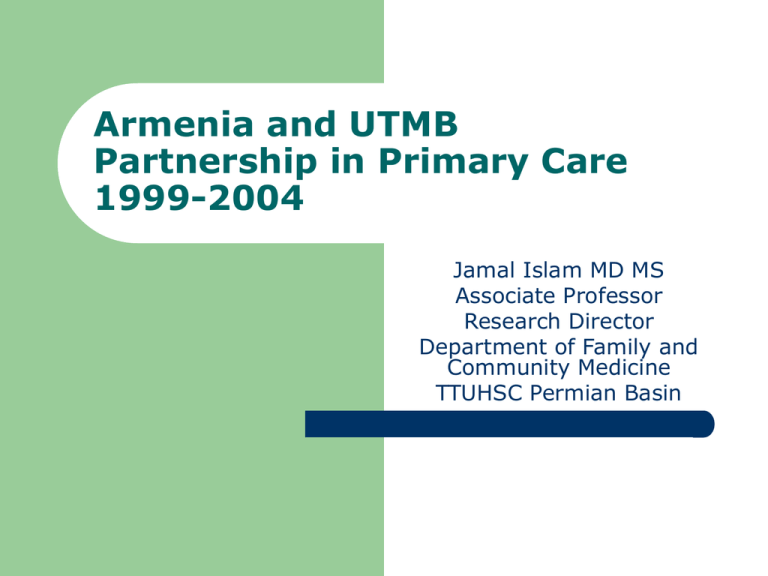
Armenia and UTMB Partnership in Primary Care 1999-2004 Jamal Islam MD MS Associate Professor Research Director Department of Family and Community Medicine TTUHSC Permian Basin USSR Before 1991 and Now Russian Socialist Federative Soviet Republic Transcaucasian Socialist Federative Soviet Republic Ukrainian Soviet Socialist Republic Byelorussian Soviet Socialist Republic Tuvan People's Republic Kresy Bessarabia Finnish Karelia Estonia Latvia Lithuania Russia Belarus Ukraine Moldova Georgia Armenia Azerbaijan Kazakhstan Uzbekistan Turkmenistan Kyrgyzstan Tajikistan Estonia Lithuania Latvia ARMENIA Over 4000 years as a state First Christian state Independence from USSR September 1991 Area 11,483 sq mile Landlocked Administrative division: 11 Region Capital: Yerevan Population 3.79 million (2000) https://www.cia.gov/library/publications/the-world_factbook/geos/am.html Demographics Population – Comparison 2,967,004 estimate 2009 Azerbijan Georgia Turkey USA Birth rate Death rate Growth rate Migration 8,041,000 5,262,000 66,668,000 283,230,000 12.65/1000 8.34/1000 - 0.03% - 4.56/1000 In World 160th 100th 207th 162th Health Indicators & Health worker ARMENIA Life expectancy at birth 69 (M) 76 (F) Birth rate 12.6/1000 Infant mortality 20.2/1000 Physicians 360/100,000 Nurses 481/100,000 USA 75 (M) 81 (F) 14.0/1000 6.9/1000 416/100,000 836/100,000 Health system WHO rank Expenditure per capita 38 $6,096 104 $63 Demographics Median Years 0-14 15-64 65> % 18.2 71.1 10.6 M F 28.8 34.4 289,119 986,764 122,996 252,150 1,123,708 192,267 Health Problems CVD HTN Smoking related lung disease Maternal and child health Breast Cancer Respiratory disease in children Common Diseases Mortality (Per 100,000) USA (Whites) CVD Overall death MI death Stroke Cancer death MVA death Intoxication Infectious disease 350 225 94 98 41 41 8.5 324 187 44 187 15 13 Health Care System in Armenia In 1991 dissolution of USSR placed 300 million in jeopardy for their social and health care. Armenia 3.75 million people were affected Annals of Internal Medicine 1993; 119:324-328 USSR health care system The Semashko model Centrally financed through the state Public owned facilities State totally controls the distribution of all health resources. planning, allocation of resources and managing capital Expenditures through central, regional and local administrator No public debate or input allowed Health Care Delivery System Based around hospitals – Republic hospitals had 1000-2000 beds – Regional and district had 50-250 beds Outpatient care provided by – Polyclinics (adjacent to hospital) 1000 visits/day – Village level primary care stations run by paramedics and midwife OTHER – Military, transportation and Elite hospitals – Maternity hospitals at republic level and occasionally at other levels too Health care system in transition 2005 Basic Package: hygiene and anti-epidemic control, primary healthcare, medical care for children, obstetrics, care for socially vulnerable groups, communicable and noncommunicable disease control, and the emergency healthcare program Expansion of basic services 2006 All services provided by polyclinic Services not provided is paid out of pocket – Estimated out of pocket is 45% of service State owned hospitals and Polyclinics are now semi autonomus, self-financing enterprises. Government payment Hospitals bed/day in 2006 $25.7 Outpatient per enrolled patients ? Average Salary state owned 2006 – General Practitioner US$ 110/month – Nurses US$ 87/month J Public Health (2008) 16:183–190 American International Health Alliance “A nonprofit organization that facilitates and manages twinning partnerships between institutions in the United States and their counterparts overseas” Targets: – Objective – – Nation and communities with limited resources Advance global health Build institutional & human resource capacity Method: – – – Peer-to-peer partnership knowledge transfer Volunteer time to the project Logistics provided http://www.aiha.com/en/ Funding for AIHA United States Agency for International Development (USAID) Started funding in 1993 US Department of Health and Human Services Health Resources and Services Administration (HRSA) World Health Organization (WHO) Global Fund to Fight AIDS, Tuberculosis and Malaria German Society for Technical Cooperation (GTZ). ARMENIA PARTNERSHIPS Cooperative Agreement Fund USAID 1. Yerevan/Boston, Massachusetts, 1999* – 2. Yerevan/Los Angeles, California, 1999* – UCLA Medical Center – Nursing: faculty training, improve program 3. Armavir/Galveston, Texas, 1999-2004. ** – Boston Univ. Medical Center – training nurse and pedi emergency/trauma UTMB - primary care 4. Gegarkunik/Providence, Rhode Island,19992004** – Care New England – primary care http://pdf.usaid.gov/pdf_docs/PDACG218.pdf Armenia Partenerships 5. Lori/Los Angeles, California, 1999-2004** – 6. Lori/Milwaukee, Wisconsin, 2003-2004 – Center for Int. Health- Primary care training program 7. Yerevan/Birmingham, Alabama, 1999-2002** – UCLA Medical Center- primary care Univ of Alabama- post graduate training; administrators 8. Yerevan/Washington, DC, 2000-2004 – Armenian American Cultural Association and Washington Hospital Center- Breast and cervical cancer prevention THE PROGRAM IN NUMBERS (Fiscal Years 1999-2004) 8 = Armenia partnerships 87 = US partner who traveled on exchanges to Armenia 118 = Armenian partners who traveled on exchanges to US 389 = Total individual exchange trips (in both directions) 103,000 = Served by the 3 PHC centers established $8.4 million = Total USAID funding $10+ million = Value of in-kind contributions by US partners Partnership Model Voluntarism: significant in-kind contributions of human, material, and financial resources Institution-based partnering for capacity-building and systematic change Peer-to-peer collaborative relationships that build mutual trust and respect Transfer of knowledge, ideas, and skills through professional exchanges and mentoring Partnership Model Benefits flowing in both directions Replication and scaling-up of successful models Sustainability of achievements and relationships “Partnership of partnerships” for networking, sharing, and creating common approaches and solutions Armavir and UTMB Partnership Goal – Improve the health of individuals in the Armavir region through primary care services ARMAVIR Distance from capital: 30 miles Area: 483 sq mile Population 330,000 3 general hospitals 2 maternity hospitals 11 polyclinics 7 health centers REGIONAL HEALTH CARE Armavir – Physician – Nurses – Field visitors – Lab assistant – Technical staff Vagharshapat Metsamor Baghramyan 131 333 25 14 234 POLICLINIC (Our Base) Out patient follow-up 2000/doctor General practitioner Neurologists Ophthalmologists Dermatologist Surgeons Cardiologist Endocrinologist Infection specialist Psychiatrist Gastroenterologist Clinical/Biochemistry 15 3 2 2 2 2 1 1 1 1 3 Service Biochemistry ECG Xray EGD Objectives Increase training and training capacity. Increase continuing education for nurses. Improve record keeping. Expand diagnostic laboratory capabilities in areas including management, calibration of equipment, blood safety, and infection control. Encourage healthy lifestyles. Expand a multidisciplinary approach to disaster preparedness Intervention Educate a core number of health professionals on screening, monitoring, using treatment guidelines, and patient education: – – – – Cardiovascular disease Diabetes Breast cancer Disaster preparedness Intervention Medical record keeping (medical cards) Standardization of laboratory and quality control School teacher education on hygiene, infections, emergency preparedness, domestic violence, and smoking cessation. Performance indicator to be measured Establishing a learning resource center Training of 56 physicians and credentialing them through the national institute of health of Armenia Training 112 nurses and credentialing Identify 80% of patients with diabetes, breast cancer and cardiovascular disease and monitor Proportion of medical cards completed Baseline Survey Multistage cluster sampling Hybrid self and interviewee administered 1019 household 3 towns 16 villages Demographics (S.D) Mean age years 35.6 (10.6) Mean years of living in area 26.1 (13.0) Mean Household member 5.3 (2) Mean room 3.3 (1.2) Cooking(%) Pipe Gas 35.8, Tank Gas 18.5, Electric 36.6, Coal 4.8 Washing machine 44% Indoor toilet 38% Color TV 43% Telephone 43% Computer 1.5% Automobile 20% Perception of health Own health status – Satisfied – Dissatisfied 14.3% 49.8% Children – Fair – Poor 52% 17.3 Health utilization 69% never sees doctor for preventive exam 11.9% ever checked cholesterol 12% ever screened for HTN 47% female never had pap smear 6.3% female ever had mammogram Depression Measured 20 scale CES-D < 17 17- 22 > 23 No depression Possible Probable 22.3 % 22.3 % 55.4 % Addiction Tobacco male:female 28.5% 22:1 Alcohol 14.2% Drug addiction 0.3% Self Reported Disease Hypertension 29% Vision problem 27.8% Mental disorder 5.6% Diabetes 3.1% Cancer 0.1% Accidents that required health care 26.5% RESULTS: Established LRC with trained person Computer installed with internet connection to access information and establish email link with UTMB Galveston RESULTS UTMB: Eleven physician and nine nurses completed the Train the trainers course Armavir: 183 physicians, 352 nurses were trained by the trainers in several diseases: CVD, CVA, breast cancer, diabetes, personal safety, infection control, substance abuse, pediatric asthma and GI infection RESULTS Increased continuing nurse education Improved record keeping Started Patient education on healthy life style Expanded diagnostic laboratory capabilities Laboratory equipment standardization, training on equipment Introduced universal precaution Interventions Results School teachers 15 trained on hygiene, infections, emergency preparedness, domestic violence, smoking cessation Disaster Planning Mock disaster training carried out 150 participants were trained on the use of defibrillators, torches, and radio telephones. They also learned about EMS system in the United States Galveston Hurricane preparedness administration model introduced Sister city partnership with Galveston led to promise of donating surplus medical emergency equipments SUCCESS? Left a new concept of health care delivery Creation of local capacity for “change” Physicians exposed to a broader aspect of health care delivery Nurses understanding and appreciation of their increased role in healthcare delivery Importance of outreach services, screening and prevention Lessons Learned Resolving health care delivery is very complex Nurse training crucial Buy in from physicians essential Working with administration essential Do not undermine partners pride Patience needed Teaching institutes need to provide time and effort for helping to improve health of the world population Proactive team needed in all teaching institutions for International Health Thank you QUESTIONS?
